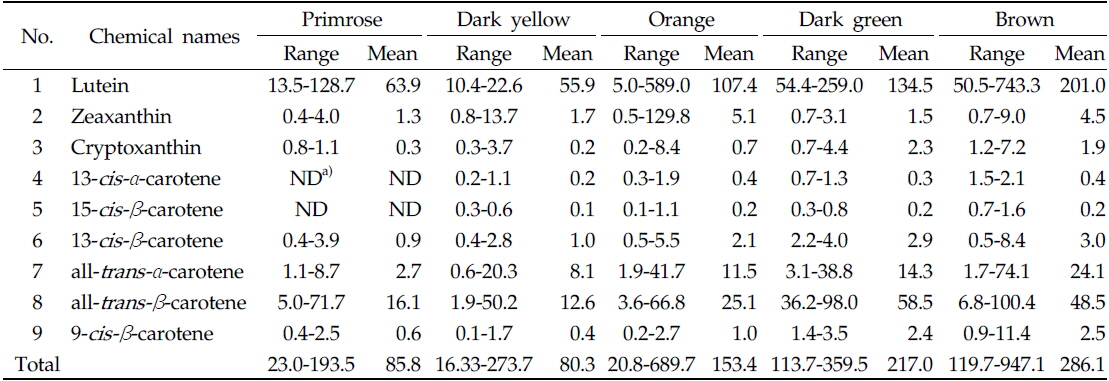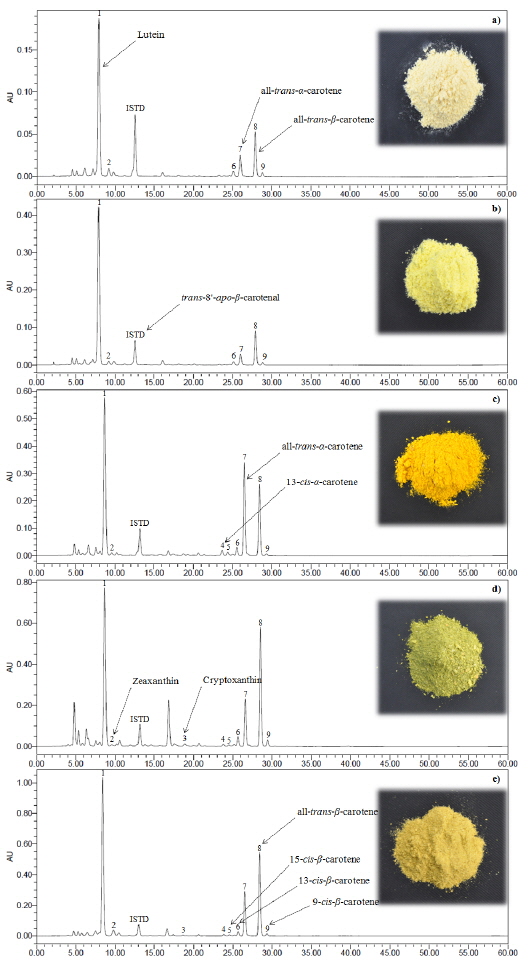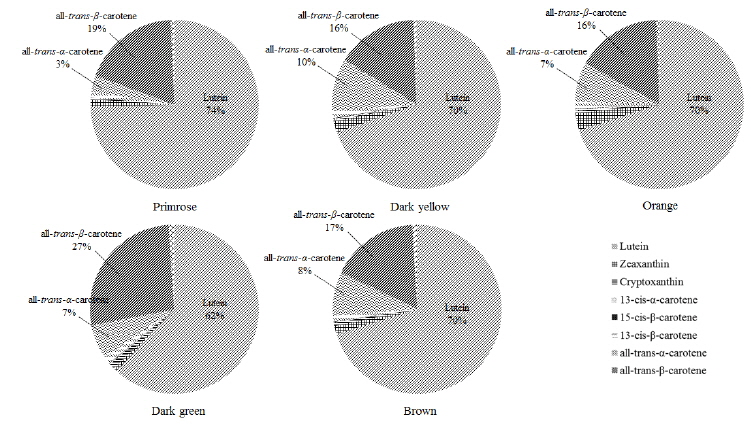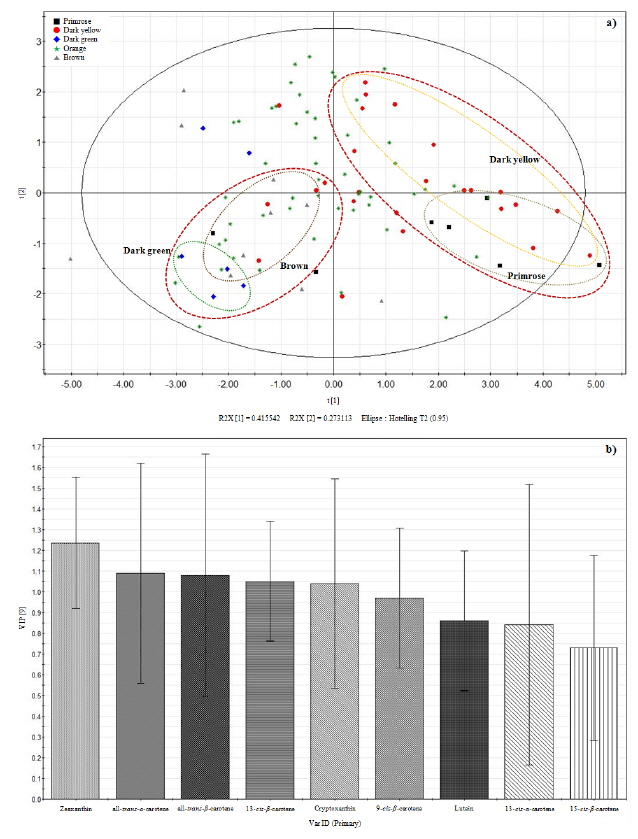



Carotenoids which are a major source of vitamin A are contributed to have great potential role in anti-carcinogenic effects and eyesight. Carotenoids which can not synthesize in human body are required for food supply. The objectives of this study are to investigate compositions and contents of pumpkin (
Carotenoids were extracted with 0.2% ascorbic acid in ethanol and saponified with 80% potassium hydroxide. Insoluble compounds were extracted into hexane. A total of nine carotenoids (three xanthophylls and six carotenes) were identified from pumpkin germplasms using HPLC equipped with photodiode array detector (450 nm). Especially, lutein and
This study indicated that dark color of pumpkin pulp was presented in high-level of biological pigments. It may contribute to develop potentially beneficial functional food ingredients.
호박 (
카로테노이드는 isoprene에서 유도되어 C40의 구조를 갖는 화합물이다. 주로 과실, 꽃, 잎에 존재하며 노란색, 주황색, 적색 등 다양한 색을 나타내는 천연 식물색소이다 (Khoo
카로테노이드는 체내에서 합성되지 않기 때문에 농 식품으로부터 섭취해야 한다. 따라서 본 연구에서는 호박 유전자원내 카로테노이드 함량을 분석하여 카로테노이드 고함유 유전자원 선발 및 과육색에 따른 함량 비교를 통하여 고함유 품종 개발을 위한 기초자료로 활용하고자 하였고 뿐만 아니라 기능성 소재로서 활용가치를 조사하고자 하였다.
본 연구에 사용된 호박 시료는 농촌진흥청 국립농업과학원 유전자원센터로부터 총 100종을 분양받았다. 과육색에 따라 연노랑색 7종, 진노랑색 25종, 주황색 52종, 진녹색 6종, 황토색 10종으로 분류하였다. 분석 전 시료로 사용하기 위하여 모든 유전자원은 동결건조한 후 곱게 분말하였다.
추출 및 분석 용매로 사용한 ethanol (EtOH), hexane, methanol (MeOH) 및 초순수는 Fisher Scientific (Fair Lawn, NJ, USA)를 사용하였고 methyl
균질화된 시료 0.5 g을 50 mL Falcon-tube에 담고 0.2% ascorbic acid in EtOH 20 mL를 넣은 다음 항온수조(80℃)에서 15분간 추출 한 후 냉각(10분)한다. 추출액에 80% KOH 용액 5 mL을 넣고 항온수조에서 10분간 비누화 반응 후 냉각 (10분)한다. 냉각 후 반응이 정지된 tube에 초순수 5 mL, hexane 5 mL와 내부표준물질 (
>
HPLC를 이용한 카로테노이드의 조성 및 함량 분석
분석 컬럼은 YMC carotenoid (250 × 4.6 mm, i.d., 5 μm) (YMC Inc., Wilmington, USA)를 사용하였다. 컬럼 오븐 온도는 40℃로 설정하였으며, 시료 주입량은 10 μL, 검출파장은 210-600 nm (대표파장 450 nm)로 하였다. 이동상으로는 용매A (MeOH:MTBE:water:triethylamine=81:15:4:0.1, v/v/v/v)와 용매B (MeOH:MTBE:water:triethylamine=6:90:4:0.1, v/v/v/v)를 사용하였고, 유량은 1.0 mL/min 로 하였다. 용매 구배조건은 B를 0%로 시작하여 5분까지 유지시켰고 35분까지 일정하게 50%로 증가시켰다. 45분까지 100%로 증가시켰고 5분 동안 유지하였다. 55분까지 다시 0%로 감소시키고 60분까지 유지하였다(modified from Kim
모든 유전자원의 카로테노이드 정량 및 과육색 정보를 바탕으로 데이터를 표준화한 후, SIMCA-P 11.0 software(Umetrics, Umea, Sweden)의 부분최소자승판별법(partial least squares of discriminant analysis: PLS-DA) 모델을 통해 클러스터 분석을 하였다.
호박 유전자원으로부터 총 9종 (lutein, zeaxanthin, cryptoxanthin, 13-
과육색에 따른 호박 유전자원 내 카로테노이드 함량 분석 결과, 총 카로테노이드 함량 범위는 연노랑(23.0-193.5 mg/100 g dw), 진노랑(16.33-273.7), 주황색(20.8-689.7), 진녹색 (113.7-359.5), 황토색 (119.7-947.1)으로 비슷한 과육색 내에서도 유전자원 간 차이가 나는 것으로 나타났다 (Table 1). 그러나 총 함량 평균은 과육색이 진할수록, 황토색(평균 286.1 mg/100 g dw) > 진녹색(217.0) > 주황색(153.4) > 연노랑(85.8) > 진노랑(80.3) 순으로 높았다. 이는 종이 다른 호박(

Carotenoid contents (mg/100 g dry weight) in different pulp color of pumpkin (Cucurbita spp.) germplasms
과육색에 따른 각 집단 간의 카로테노이드 조성 및 함량에 대한 상관관계를 PLS-DA score plotting을 확인하였다(Fig. 3). 과육색이 주황색인 집단은 유전자원별 편차가 크므로 넓은 분포를 나타내었다. 상대적으로 카로테노이드 함량이 높은 진녹색과 황토색 집단은 유사한 경향을 나타내었다. 또한 상대적으로 카로테노이드 함량이 낮은 집단에 속하는 진노랑은 넓은 범위의 분포를 나타내었으나 전체적으로 연노랑 집단과 클러스터를 형성하는 것을 확인하였다. 이러한 집단간 분포에 가장 큰 영향을 미친 성분은 zeaxanthin, all-
과육색이 다른 호박 유전자원 내 카로테노이드 조성 및 함량을 조사한 결과, 과육색에 따른 함량 변화만 있었고, 총 9 종이 검출되었다. 호박 내 주요 성분은 lutein, all-






